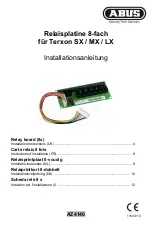
GE Power Management
750/760 Feeder Management Relay
15-
5
15 S8 TESTING
15.4 SIMULATION
15
15.4 SIMULATION
15.4.1 DESCRIPTION
W HEN IN SIM ULATIO N M ODE, THE NO RM AL PRO TECTIO N AND CO NTRO L FEATURES ARE
NOT OPERATIONAL. THIS IS INDICATED BY THE ‘8 SELF-TEST WARNING’ RELAY BEING DE-
ENERG IZED. IF SIM ULATION M ODE IS USED FO R FIELD TESTING ON EQUIPM ENT, THE OPER-
ATOR M UST PROVIDE OTHER M EANS OF PROTECTION AND CONTROL.
A simulation feature is provided for testing the functionality of the relay in response to program conditions, with-
out the need of external AC voltage and current inputs. First time users will find this to be a valuable training
tool. System parameters such as currents and voltages, phase angles, and system frequency are entered as
setpoints. When placed in simulation mode, the relay suspends reading actual AC inputs, generates samples
to represent the programmed phasors, and loads these samples into the memory to be processed by the relay.
Both normal and fault conditions can be simulated to exercise a variety of relay features. There are three sets
of input parameters used during simulation, each providing a particular state of the system, as shown below:
Prefault State
: This state simulates the normal operating condition of a feeder carrying load current, by
replacing the normal input parameters with programmed prefault values. Voltages are auto-
matically set to the nominal value programmed in the
BUS VT NOMINAL SECONDARY VOLTAGE
setpoint. The neutral current is set to zero. Phase currents are balanced and set to the value
programmed in the
PREFAULT PHASE A/B/C CURRENT
setpoint. The phase angle of each phase
current relative to its corresponding phase neutral voltage is set to the value programmed in
the
PREFAULT POWER FACTOR ANGLE
setpoint. The frequency of voltages and currents are auto-
matically set to the values programmed in the
NOMINAL FREQUENCY
setpoint.
Fault State
:
This state simulates the faulted operating condition of a feeder by replacing the normal pre-
fault feeder input parameters with programmed fault values. The magnitude and angle of each
bus voltage and current, polarizing current, system frequency and analog input are set to the
values programmed under the
FAULT VALUES
setpoints. The neutral current is calculated from
the vector sum of the phase currents, and 3
V
o
from the vector sum of the phase voltages.
Postfault State
:This state is intended to simulate a feeder that has tripped. Current is automatically set to 0
amps. Bus voltages are automatically balanced and set to phase A-N at 0
°
, B-N at 120
°
and
C-N at 240
°
. The bus voltage magnitude and frequency are set to the entered values. The syn-
chronizing voltage is set to the entered values of magnitude, angle (with respect to phase A-N
bus voltage) and frequency.
There are two methods of running simulations. If the feeder circuit breaker is connected to the relay and can be
opened and closed, a full operating sequence can be performed. If a breaker is not available, as is often the
case, the relay can be made to simulate a breaker and allow the 760 to exercise its autoreclose feature. The
operation of each method is described below.
1.
If simulation of the feeder breaker is required set the
CIRCUIT BREAKER SIMULATION
setpoint to
Enabled
.
After the required simulation setpoints have been entered, the relay is placed in the Prefault State by set-
ting the
SIMULATION STATE
setpoint to
Prefault
. The relay replaces the normal AC inputs with those pro-
grammed on the
PREFAULT VALUES
setpoint page. Logic inputs, except for the 52a and 52b contacts, are
monitored normally throughout the simulation. The relay’s simulation of a circuit breaker is indicated by the
status of the Breaker Open and Breaker Closed front panel indicators.
The relay remains in the Prefault State until a command is received to enter the Fault State, either by (a)
setting the
SIMULATION STATE
setpoint to the
Fault State
, or (b) a contact closure on a logic input whose
function setpoint is set to
Simulate Fault
. The logic input makes the measurement of feature operating
times possible when output relays are allowed to operate.
In the
Fault State
, relay features respond to the programmed fault values, generating a trip, alarms, event
records, triggers of trace memory and data logger, and front panel indications as necessary. Output relays
only operate if permitted by the
ALLOW OPERATION OF RELAYS (3-7)
setpoint. The relay remains in the
Fault
State
until it has detected a trip condition. Note that the 1 TRIP relay is not allowed to operate. At this time
the simulated breaker is opened (as indicated by front panel indicators) and the relay is placed in
Postfault
State
.
CAUTION
Summary of Contents for 750
Page 2: ......
Page 4: ......
Page 124: ...8 14 750 760 Feeder Management Relay GE Power Management 8 12 INSTALLATION 8 S1 RELAY SETUP 8 ...
Page 488: ...A 4 750 760 Feeder Management Relay GE Power Management A 1 FIGURES AND TABLES APPENDIXA A ...
Page 492: ...C 2 750 760 Feeder Management Relay GE Power Management C 1 WARRANTY INFORMATION APPENDIXC C ...
Page 502: ...x 750 760 Feeder Management Relay GE Power Management INDEX ...
Page 503: ...GE Power Management 750 760 Feeder Management Relay NOTES ...
















































